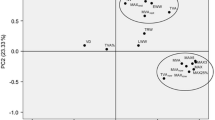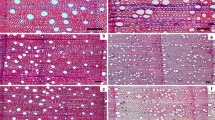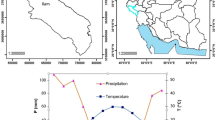Abstract
Key message
Radial growth and wood anatomical variables of G. kola have a direct relationship with climate. Rainforest regions are more suitable and could be recommended for stakeholders for conservation action plans.
Abstract
Tropical agroforestry species are characterized by irregular growth and fruiting pattern, this is because of seasonal differences in the region and unanticipated environmental changes. Tree-ring width features and vessel variables could have a direct relationship with environmental conditions and factors such as precipitation and temperature could impact the growth of the species. This is because, during stressful environmental conditions, tree species record environmental changes through their physiological adjustment. Therefore, wood anatomical and tree-ring width time series was developed for Garcinia kola, a multipurpose tropical species, from a humid forest zone and derived savannah, along two vegetation zones in Nigeria. The species forms rings characterized by marginal parenchyma. The mean tree-ring width (TRW) ranges from 2.63 and 2.30 mm in the humid forest zone and derived savannah, respectively while the vessel number (VN) and vessel density (VD) are 95, 93, and 9.46, and 10.28 N/mm2 respectively. The results revealed that the radial growth of G. kola showed a positive relationship with the precipitation and the minimum temperature during the peak of the rainy season in derived savannah areas. The VN, RW, and TVA show a significant relationship with the mean annual maximum temperature in the Rainforest and derived savannah area. The vessels are more abundant in samples from the rainforest area than in the derived savannah area, the results revealed that the wood anatomical variables and TRW were sensitive to climatic variables. Hence, they could be good indicators for evaluating tropical tree responses to environmental changes in tropical agroforestry species.









Similar content being viewed by others
Data availability
All the necessary data will be make available on request.
References
Agwu OP, Bakayoko A, Jimoh SO, Stefan P (2018) Farmers’ perceptions on cultivation and the impacts of climate change on goods and services provided by Garcinia kola in Nigeria. Ecol Process 7(1):1–10
Agwu OP, Bakayokoa A, Jimoh SO, Dimobe K, Porembski S (2020) Impact of climate on ecology and suitable habitat of Garcinia kola Heckel in Nigeria. Trees for People 1:100006
Avakoudjo HGG, Gebrekirstos A, Koné MW, Assogbadjo AE, Bräuning A (2022) Wood anatomy and vessel characteristics of spiny monkey orange (Strychnos spinosa) in Benin (West Africa). Dendrochronologia 72:125941
Balima LH, Gebrekirstos A, Kouamé FNG, Nacoulma BMI, Thiombiano A, Bräuning A (2020) Life-span growth dynamics and xylem anatomical patterns of diffuse-porous Afzelia africana Sm.(Fabaceae) in different ecological zones in Burkina Faso. Dendrochronologia 64:125752
Boakye EA, Gebrekirstos A, Hyppolite DN, Barnes VR, Kouame FN, Porembski S, Brauning A (2016) Influence of climatic factors on tree growth in riparian forests in the humid and dry savannahs of the Volta basin, Ghana. Trees 30(5):1695–1709. https://doi.org/10.1007/s00468-016-1401-x
Bolanle – Ojo OT, Afolabi JO, Fapojuwomi OA (2015) Domestication of Garcinia kola Heckel.: effect of light intensities on early growth performance. In: Conservation in 21st Century Nigeria: transcending disciplinary boundaries, Amusa TO, Babalola FD (eds). Proceedings of Nigeria Tropical Biology Association (NTBA). 5th Annual Biodiversity Conference, FUTA, pp 52–57
Bolanle-Ojo OT, Yakubu FB, Williams OA, Yahaya DK, Asabia LO (2014) Seedling growth performance of Kigelia africana (Lam.) Benth. as influenced by different light intensities. Eur J Agric for Res 2(3):1–13
Charles RL, Munishi PKT, Nzunda EF (2013) Agroforestry as adaptation strategy under climate change in Mwanga District, Kilimanjaro, Tanzania. Int J Environ Prot 3(11):29–38
Devall MS, Parresol BR, Wright SJ (1995) Dendroecological analysis of Cordia alliodora, Pseudobombax septenatum and Annona spraguei in central Panama. IAWA J 16(4):411–424
Dünisch O, Montóia VR, Bauch J (2003) Dendroecological investigations on Swietenia macrophylla King and Cedrela odorata L. (Meliaceae) in the central Amazon. Trees 17(3):244–250
Enquist BJ, Leffler AJ (2001) Long-term tree ring chronologies from sympatric tropical dry-forest trees: individualistic responses to climatic variation. J Trop Ecol 17(1):41–60
Evert RF (2006) Esau’s plant anatomy: meristems, cells, and tissues of the plant body: their structure, function, and development. John Wiley & Sons, New York
Fonti P, Babushkina EA (2016) Tracheid anatomical responses to climate in a forest-steppe in Southern Siberia. Dendrochronologia 39:32–41. https://doi.org/10.1016/j.dendro.2015.09.002
Fritts HC, Shatz DJ (1975) Selecting and characterizing tree-ring chronologies for dendroclimatic analysis. Tree Ring Bull 35:31–40
García-González I, Eckstein D (2003) Climatic signal of earlywood vessels of oak on a maritime site. Tree Physiol 23:497–504. https://doi.org/10.1093/treephys/23.7.497
Gebrekirstos A, Mitlohner R, Teketay D, Worbes M (2008) Climate–growth relationships of the dominant tree species from semi-arid savannah woodland in Ethiopia. Trees 22:631–641
Gebrekirstos A, Brauning A, Van Noordwijk M, Mitlohner R (2011) Understanding past, present, and future climate changes from East to West Africa. Agric Innov Sustain Dev 3:77–86
Gebrekirstos A, Bräuning A, Sass-Klassen U, Mbow C (2014) Opportunities and applications of dendrochronology in Africa. Sustain Chall 6:48–53
Girmay D, Girmay B, Emiru A, Nigussie, (2015) Woody species diversity in Oxytenanthera abyssinica based homestead agroforestry systems of Serako, northern Ethiopia. J Nat Sci Res 59(2015):18–16
Hacke UG, Sperry JS (2001) Functional and ecological xylem anatomy. Perspect Plant Ecol Evol Syst 4(2):97–115
Islam M, Rahman M, Bräuning A (2019) Impact of extreme drought on tree ring width and vessel anatomical features of Chukrasia tabularis. Dendrochronologia 53:63–72. https://doi.org/10.1016/j.dendro.2018.11.007
IUCN (2019) The IUCN Red List of Threaten Species. Version 2019 https/www.iucnredlist.org
Jacoby GC Jr, D’Arrigo RD (1990) Teak (Tectona grandis LF), a tropical species of large-scale dendroclimatic potential. Dendrochronologia 8:83–98
Koffi EN, Rayner PJ, Norton AJ, Frankenberg C, Scholze M (2015) Investigating the usefulness of satellite-derived fluorescence data in inferring gross primary productivity within the carbon cycle data assimilation system. Biogeosciences 12:4067–4084. https://doi.org/10.5194/bg-12-4067-2015
Latamo LL (2021) A review on the indigenous multipurpose agroforestry tree species in Ethiopia: management, their productive and service roles and constraints 7 (9) https://doi.org/10.1016/j.heliyon.2021.e07874
Nath V, Kumar G, Pandey SD, Pandey S (2019) Impact of climate change on tropical fruit production systems and its mitigation strategies. Climate change and agriculture in India: impact and adaptation. Springer, Cham, pp 129–146
Pourtahmasi K, Lotfiomran N, Bräuning A, Parsapajouh D (2011) Tree-ring width and vessel characteristics of oriental beech (Fagus orientalis) along an altitudinal gradient in the Caspian forests, Northern Iran. IAWA J 32(4):461–473
Priya PB, Bhat KM (1999) Influence of rainfall, irrigation and age on the growth periodicity and wood structure in teak (Tectona grandis). IAWA J 20(2):181–192
R Core Team (2021) R: a language and environment for statistical computing. In: R Foundation for Statistical Computing, Vienna, Austria. URL https://www.R-project.org. Assessed 30 June 2021
Rahman M, Islam M, Bräuning A (2017) Local and regional climatic signals recorded in tree-rings of Chukrasia tabularis in Bangladesh. Dendrochronologia 45:1–11. https://doi.org/10.1016/j.dendro.2017.06.006
Rakthai S, Fu PL, Fan ZX, Gaire NP, Pumijumnong N, Eiadthong W, Tangmitcharoen S (2020) Increased drought sensitivity results in a declining tree growth of Pinus latteri in Northeastern Thailand. Forests 11(3):361
Roel A, Mutters RG, Eckert JW, Plant RE (2005) Effect of low water temperature on rice yield in California. Agron J 97(3):943–948
Schulman E (1956) Dendroclimatic changes in Semiarid America. University of Arizona Press, Tucson
Schweingruber FH, Bartholin T, Schaur E, Briffa KR (1988) Radiodensitometric-dendroclimatological conifer chronologies from Lapland (Scandinavia) and the Alps (Switzerland). Boreas 17(4):559–566
Speer JH (2010) Fundamentals of tree-ring research. University of Arizona Press, Tucson
Sperry JS (2003) Evolution of water transport and xylem structure. Int J Plant Sci 164(S3):S115–S127
Sperry JS, Meinzer FC, McCulloh KA (2008) Safety and efficiency conflicts in hydraulic architecture: scaling from tissues to trees. Plant Cell Environ. https://doi.org/10.1111/j.1365-3040.2007.01765.x
Stahle DW, Mushove PT, Cleaveland MK, Roig F, Haynes GA (1999) Management implications of annual growth rings in Pterocarpus angolensis from Zimbabwe. For Ecol Manage 124(2–3):217–229. https://doi.org/10.1016/S0378-1127(99)00075-4
Steppe K, Lemeur R (2007) Effects of ring-porous and diffuse-porous stem wood anatomy on the hydraulic parameters used in a water flow and storage model. Tree Physiol 27(1):43–52
Stokes MA, Smiley TL (1968) An introduction to tree-ring dating. University of Chicago Press, Chicago
Toledo M, Poorter L, Peña-Claros M, Alarcón A, Balcázar J, Leaño C, Licona JC, Llanque O, Vroomans V, Zuidema P, Bongers F (2011) Climate is a stronger driver of tree and forest growth rates than soil and disturbance. J Ecol 99(1):254–264
Wigley TML, Briffa KR, Jones PD (1984) On the average value of correlated time series, with applications in dendroclimatology and hydrometeorology. J Clim Appl Meteorol 23:201–213
Worbes M (1999) Annual growth rings, rainfall-dependent growth and long-term growth patterns of tropical trees from the Caparo Forest Reserve in Venezuela. J Ecol 87(3):391–403
Zang C, Biondi F (2015) Treeclim: an R package for the numerical calibration of proxyclimate relationships. Ecography 38(4):431–436. https://doi.org/10.1111/ecog.01335
Funding
This project is sponsored by DAAD climapAfrica programme, Climate change research Alumni and Postdocs in Africa for future leaders in the field of climate research and protection.
Author information
Authors and Affiliations
Corresponding author
Ethics declarations
Conflict of interest
The authors declare that they have no conflict of interest.
Additional information
Communicated by Holger Gärtner.
Publisher's Note
Springer Nature remains neutral with regard to jurisdictional claims in published maps and institutional affiliations.
Rights and permissions
Springer Nature or its licensor (e.g. a society or other partner) holds exclusive rights to this article under a publishing agreement with the author(s) or other rightsholder(s); author self-archiving of the accepted manuscript version of this article is solely governed by the terms of such publishing agreement and applicable law.
About this article
Cite this article
Agwu, O.P., Gebrekirstos, A., Ogana, F.N. et al. Vessel characterization and ring-width of a multipurpose agroforestry tree species (Garcinia kola.(Heckel)) and its relationship with climate in Nigeria. Trees 38, 139–150 (2024). https://doi.org/10.1007/s00468-023-02471-9
Received:
Accepted:
Published:
Issue Date:
DOI: https://doi.org/10.1007/s00468-023-02471-9




